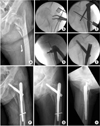Abstract
Purpose
The purpose of this study is to analyze the results of intertrochanteric fractures treatment with proximal femoral nail antirotation (PFNA) without using fracture tables and thereby prevent complications.
Materials and Methods
Forty cases of intertrochanteric fracture of 39 patients that were treated with PFNA without using fracture tables between January 2008 to December 2009 were analyzed. There were 13 males and 27 females. The mean age was 76 years old. Using AO classification, 6 cases were A1, 25 cases were A2 and 9 cases were A3. The operation was done without using fracture tables at supine position. Operation time, intraoperative bleeding were checked. For the result, Cleveland index, tip apex distance, fracture site sliding rate, change of femur neck and shaft angle were evaluated. Bone union time and complications were also estimated from the follow up radiograph. Statistics were analyzed using Independent T-test.
Results
The mean operation time was 40 minutes (25 to 70 minutes) and mean intraoperative bleeding was 113 cc (40 to 250 cc). The Cleveland index was shown 94% of 5, 6, 8 and 9 zone, the tip apex distance was 12.96 mm (6 to 22 mm), the fracture sliding distance was 1.9 mm (0 to 6 mm), the change of femur neck and shaft angle was 2.5 degree (0~10 degree) and the average bone union time was 15 weeks (8 to 24 weeks). The complication include 2 cases of delayed union and 2 cases of varus deformities.
Figures and Tables
 | Fig. 1
(A) C-arm image is checked without using fracture table preoperatively.
(B) Closed reduction is done under C-arm image.
|
 | Fig. 2
(A) Preoperative radiograph show unstable intertrochanteric fracture of a 83 year-old female.
(B) Guide wire is inserted after mannual reduction.
(C, D) Fracture site is reduced by using bone hook and guide pin inserted for blade.
(E) Fracture site is reduced on C-arm image satisfactory.
(F) Postoperative radiograph after fixation with a PFNA.
(G, H) Radiograph made 3 months postoperatively showing a bone union.
|
References
1. Baumgaertner MR, Curtin SL, Lindskog DM, Keggi JM. The value of the tip-apex distance in predicting failure of fixation of peritrochanteric fractures of the hip. J Bone Joint Surg Am. 1995. 77:1058–1064.

2. Brumback RJ, Ellison TS, Molligan H, Molligan DJ, Mahaffey S, Schmidhauser C. Pudendal nerve palsy complicating intramedullary nailing of the femur. J Bone Joint Surg Am. 1992. 74:1450–1455.

3. Chang SA, Cho YH, Byun YS, Han JH, Park JY, Lee CY. The treatment of trochanteric femoral fracture with using proximal femoral nail antirotation (PFNA). J Korean Hip Soc. 2009. 21:252–256.

4. Cleveland M, Bosworth DM, Thompson FR, Wilson HJ Jr, Ishizuka T. A ten-year analysis of intertrochanteric fractures of the femur. J Bone Joint Surg Am. 1959. 41:1399–1408.

5. Davis TR, Sher JL, Horsman A, Simpson M, Porter BB, Checketts RG. Intertrochanteric femoral fractures. Mechanical failure after internal fixation. J Bone Joint Surg Br. 1990. 72:26–31.

6. Dimon JH, Hughston JC. Unstable intertrochanteric fractures of the hip. J Bone Joint Surg Am. 1967. 49:440–450.

7. Evans EM. The treatment of trochanteric fractures of the femur. J Bone Joint Surg Br. 1949. 31B:190–203.

8. Haidukewych GJ. Intertrochanteric fractures: ten tips to improve results. Instr Course Lect. 2010. 59:503–509.
10. Jensen JS. Determining factors for the mortality following hip fractures. Injury. 1984. 15:411–414.

11. Kao JT, Burton D, Comstock C, McClellan RT, Carragee E. Pudendal nerve palsy after femoral intramedullary nailing. J Orthop Trauma. 1993. 7:58–63.

12. Kim DH, Lee SH, Moon YL, Lee JY, Song KS. Treatment of senile osteoporotic intertrochanteric fracture using proximal femoral nail. J Korean Fract Soc. 2007. 20:215–221.

13. Kim JJ, Jeong YG, Jung KH, Park SS, Kim EG. Intramedullary nailing of femoral shaft fractures: comparison between with and without the fracture table. J Korean Soc Fract. 2000. 13:320–326.

14. Lee JY, Lee SY. Treatment of the proximal femoral extracapsular fracture with proximal femoral nail antirotation (PFNA): comparison with proximal femoral nail (PFN). J Korean Hip Soc. 2007. 19:183–189.

15. Lee KJ, Min BW, Kim SG, Song KS, Bae KC, Cho CH. Results of treating senile osteoporotic peritrochanteric fracture with proximal femoral nail antirotation (PFNA). J Korean Hip Soc. 2009. 21:162–168.

16. Melton LJ 3rd, Ilstrup DM, Riggs BL, Beckenbaugh RD. Fifty-year trend in hip fracture incidence. Clin Orthop Relat Res. 1982. 162:144–149.

17. Park MS, Lim YJ, Kim YS, Kim KH, Cho HM. Treatment of the proximal femoral fractures with proximal femoral nail antirotation (PFNA). J Korean Fract Soc. 2009. 22:91–97.

18. Parker MJ, Palmer CR. A new mobility score for predicting mortality after hip fracture. J Bone Joint Surg Br. 1993. 75:797–798.

19. Richmond J, Aharonoff GB, Zuckerman JD, Koval KJ. Mortality risk after hip fracture. J Orthop Trauma. 2003. 17:53–56.

20. Sadowski C, Lubbeke A, Saudan M, Riand N, Stern R, Hoffmeyer P. Treatment of reverse oblique and transverse intertrochanteric fractures with use of an intramedullary nail or a 95 degrees screw-plate: a prospective, randomized study. J Bone Joint Surg Am. 2002. 84:372–381.





 PDF
PDF ePub
ePub Citation
Citation Print
Print



 XML Download
XML Download